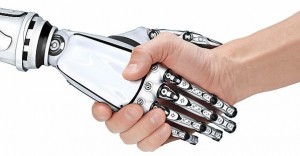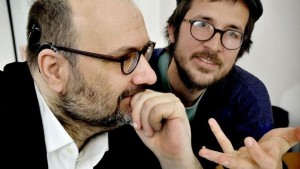New Technology – New perceiving – New media
Possibilities and social relevant debates in the field of Cyborgs
Jessica Albers & Anna Kraus
Being part of a reality in which technology and human actions visibly seem to melt more and more one might easily step upon the idea of the Cyborg. The term is short for cybernetic organism and stands broadly summarized for a fusion of the human and machines or the adaptation of the human to its environment by the help of technology.
Agents of a broad sense describe many of us already as Cyborgs since we are extending our human abilities by i.e. using smartphones or the Internet. They understand the Cyborg as a symbiotic union of the individual with ‘modern’ technologies. The Cyborg, produced by humans and constantly being changed by them, shapes at the same time people’s ways of communication, their perception and meaning of the world and understanding of what it means to be human.
As explained here by Cyborg Anthropologist Amber Case:
The narrower understanding focuses on an internal and deep fusion of organic and inorganic parts in order to become Cyborg, either out of restorative causes and/or out of the wish of enhancement. This latter notion is one of the leading urges of the transhumanist movement, which regards the Cyborg as a new phase of the human evolution with the final aim of reaching immortality.
Transhumanist, Cyborg, activist and hacker Tim Cannon actually says: “[…] as soon as they get those better arms, I’m just gonna take ‘em off and put on these better arms on […]” (Cannon 2014: 10:53-10:58 Min.)
The extending of the human frame attracts also people enticed by the possibilities of experiencing with senses and perception. For example artists like the founders of the Spain-based Cyborg Foundation:
Moon Ribas, who can feel earthquakes all over the world.
ACHTUNG: Daten nach YouTube werden erst beim Abspielen des Videos übertragen.
And Neil Harbisson – the first officially recognized Cyborg of the world who can ‘hear’ colors.
Those different understandings serve merely as an orientation within the field and are not caved in stone. But what counts the most from an anthropological perspective is the self-identification as a Cyborg and what people are doing with a concept like this.
One way to get in contact with the Cyborg scene, its people and their motivations was for us to visit a meeting of the Cyborg e.V. in Berlin. With its broader sense of a Cyborg and belief that technology has always been part of humankind, the club attracts many people with different professions and interests, some with and some without implants.
It was founded 2014 by Enno Park and Stefan Greiner, who are Cyborgs in the more narrow sense.
Enno has a Cochlear implant directly implanted in his brain, which enables him to hear again after 17 years of deafness.Stefan’s Cyborg-state originates in his wish to expand his sensual perception – he has an implant in his finger, which permits him to perceive magnetic fields.
These two serve as a good example to explain what the club does. They want to blur the lines between dichotomies like ill and healthy or natural and artificial and they try to use technology to get a better understanding of their environment. The club serves to its members as a place, where they can bounce off ideas of each other, and try out things regulated by their own policies, where they hack prostheses, implants and devices and document their functions, software and side effects. They are also working on Cyborg-rights and try to advocate for more acceptance in the society. One of their most prominent collaborated works is i.e. the connection of Stefan’s finger implant to his smartphone, so that he was able to hear the caller with just his finger in his ear.
ACHTUNG: Daten nach YouTube werden erst beim Abspielen des Videos übertragen.
Besides individual technical experiments the very well-connected Cyborg community seems to feel a great responsibility in their work and wants to use their skills for mankind. Therefore they are also developing open-source programs and advocate for free access to personal data and more transparency in the internet-use. That there is still a lot of work to do to convince society for narrower Cyborg technology can see by the reactions towards the google-glasses. The overall reactions towards them were negative as the more direct experience of google through these glasses caused a lot of protests, because of the non-transparency of personal data security and the social fear connected to data abuse following the NSA scandal.
In conclusion it is to say that the Cyborg movement is definitely one worth to be studied.A ‘Cyborganization’ of our society is in progress, and the people behind this movement are eager to modify the way we are living by changing the relationship between technology and mankind and our ways of communication and bodily interaction. Besides critical questions on who will have access to these new technologies, those developments offer a wide range of research opportunities especially from an anthropological perspective. As our discipline cares much about the everyday use, an anthropological vantage point can help to understand how people are dealing with those technological developments in their realities and how and why those might become part of their identity.
References:
Literature:
Downey, Gary Lee; Dumit, Joseph; Williams, Sarah 1995: Cyborg Anthropology. Cultural Anthropology 10 (2): 264-269
Pictures:
European Automation 2015: Das Goldene Zeitalter der Roboter beginnt erst. https://www.technica-online.ch/artikel/das-goldene-zeitalter-der-roboter-beginnt-erst/ (last accessed 26.09.2015)
Spiekermann-Klaas, Doris 2015: Enno Park (links) und Stefan Greiner. In: Der Tagesspiegel.https://www.tagesspiegel.de/themen/reportage/cyborgs-in-berlin-von-der-frage-wie-weit-verschmelzung-gehen-darf/11604982-2.html (last accessed 26.09.2015)
Additional literature:




 Die
Die